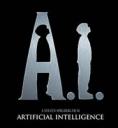A.I.
 Rated PG-13
Rated PG-13
Running Time: 145 Minutes
Written and Directed by Steven Spielberg
Screen story by Ian Watson
Based on the short story “Supertoys Last All Summer Long” by Brian Aldiss.
CAPSULE REVIEW: C+
EXTENDED REVIEW:
The high concept for this film could best be described as “Bladerunner” meets “Pinnochio”. If that sounds far-fetched, it is. Even stranger is the fact that this is a Stanley Kubrick/ Amblin Entertainment collaboration. Who would have thought that Spielberg, a master of nostalgia and feel-good sensibility would try to tackle those dark, nether regions of the human psyche, and tell a story that Stanley Kubrick (an acknowledged master of existentialist cinema) took 15 years to develop and never finished?
“But how is the movie?” you ask?
In short, not very good. I even went to see it at the Mann Chinese Theater in Hollywood, a venue whose ambience lends itself to making a film seem even better than it actually is. Don’t get me wrong. I’m not one of these shrinking violet types that only likes art house productions, either. I love spectacle and blockbuster movie fare…when it works. Unfortunately, Steven Spielberg just doesn’t have the proper sensibility to continue Kubrick’s original vision.
A.I. begins in the future, in a world drastically changed by global warming. The polar ice caps have melted and massive floods have drowned coastal cities, including New York and Los Angeles. Famine has forced population control measures. Instead of human sweatshops, however, a new breed of slave has emerged to keep the upper classes in the lifestyle to which they’ve grown accustomed – robots are built to do everything from driving cars to performing sexual favors.
Enter William Hurt, who plays Professor Hobby, a melancholy robotic engineer who’s lost his son and decides to build a fleet of child robots to fill the need for human children that have been growing scarcer and scarcer since the population control laws went into effect.
David, played by Haley Joe Osment, is his prototype boy; modern Pinnochio, who has the capacity to love and who bonds with his intended foster mother just as a human child would. Unfortunately, the only reason David was adopted was because his foster family’s real child was on the verge of death; cryogenically frozen until a cure could be found for his illness. A month into David’s adoption, however, the original son is brought back with a miracle cure, and in a series of sibling squabbles, the parents eventually decide to dump the robotic David in the woods, much like one would do with a broken toaster oven.
This begins the second half of the movie, which I found the most entertaining because of the addition of a new character; Gigolo Joe. Played by Jude Law, Gigolo Joe is a combination of Fred Astair, Gene Kelly, and James Bond, who waltzes around following his programming in an attempt to make every human woman feel like a goddess.
David explains his dilemma to Joe and then, à la Pinnochio, they set out to find the “Blue Fairy” whom David believes can turn him into a real boy.
A good set-up. Then things go down hill. Joe is caught by the police and taken away to be incinerated. David steals a helicoptor and crashes into the ocean. The Ice Age covers him over. Then, 2,000 years pass and he is rescued by aliens. The aliens revive him, and bring his foster mother back to life for a 24-hour reunion, after which they both drift off for a metaphorical “sleep”, i.e. – death!
“Wait,” you ask, “Did I just read what I thought I did?” The answer is yes.
Pretty bad, huh? There’s only so far that one can suspend one’s disbelief.
At the moments when the audience was supposed to have been crying, they were laughing at the sheer ridiculousness of these too-talkative aliens that seemed tacked on at the last minute like a bad reprise of E.T.
Steven, Steven, Steven…better luck next time.
